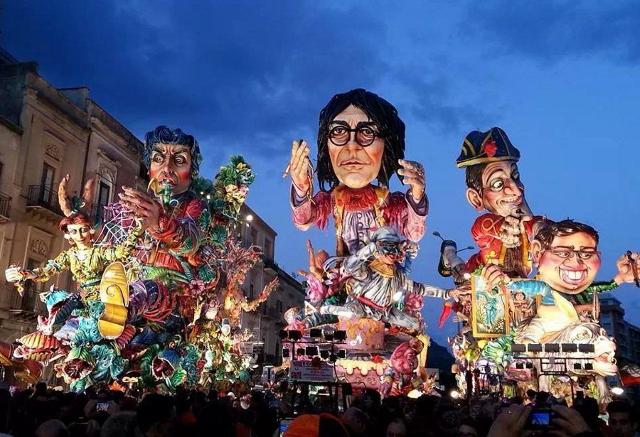What is there to visit?
Guide to your stay in Sciacca

The Carnival of Sciacca
The first to speak of Carnival, in 1889, was Giuseppe Pitrè who mentioned it in his work “Library of Sicilian folk traditions”. But the origins of the carnival of Sciacca, city of the province of Agrigento, date back to a much older period, perhaps to the Roman era, when the Saturnalia was celebrated and their king was sacrificed; or more likely, to 1616 when the viceroy Ossuna decided that on the last day of the celebration everyone had to dress up in masks.
The first manifestations are remembered as a popular festival, where sausages, cannoli and a lot of wine were consumed; and the people poured through the streets, disguised in various ways. Later the first carts were grandly decorated in their best carrying the costumed participants on chairs around the streets of the city.
In the 1920’s there was the first appearance of a large decked platform, dragged by oxen or horses, carrying groups in masks. They recited plays in local dialect, followed by small improvised orchestras. Stew, sausages and wine were distributed readily, representing a moment of meeting and exchange among fellow citizens.
After the war the carts were named, and they began to make clear reference to the innovations of progress. Streamers and confetti began to be launched from the moving carts, creating a festive atmosphere, which encouraged the participants to become the true protagonists in a joyous group. After a few years more, the delirious crowd gave rise to the first magazine agencies, and more and more sophisticated allegorical wagons were set up, which referred to local issues and personalities in satirical themes.
With the experimentation of sound amplification, the carnival of Sciacca evolved even more and carts were set up with ever larger figures and whose movements became more and more sophisticated. Local political satire gave more freedom to people and known to a wider audience, representing current issues that concerned national interests.
The allegorical floats and mini-floats, are followed by their associated masked groups, which are conceived, designed and produced in the months before carnival, involving, from the onset of the preparations, many local towns people.
Friday night is reserved for the last montages: the floats are placed in order for the parade along the street of the first parade route and are assembled on the spot. Curious people follow the progress of the work and confusion between the coming and going of various vehicles and the hustle and bustle of finishing the work to make sure that everything works properly on the float. In fact, even though the floats are designed and built in the previous months, the various “pieces” are assembled for the first time in the street and only the night before the start of the parade. Several times, several wagon drivers had to modify the float right at the last minute due to problems with the final assembly, running the risk of not participating.
Finally comes the day of the parade that follows two routes in the historic center of Sciacca. The parades are held on Saturday (first route), Sunday, Monday and Tuesday (second route) on the week before the beginning of Lent.
Nowadays the Carnival begins on Holy Thursday with the symbolic delivery of the key of the city to the king of the Carnival Peppe Nappa, adopted by the Saccensi as a local character that opens and closes the carnival. The beginnig of the procession of the floats, with Peppe Nappa’s float at the head, takes place from Piazza Friscia.
From the first moment, the Peppe Nappa float, parading through the streets of the city, begins to distribute wine and sausages prepared on the grill for the duration of the carnival. The last night of Shrove Tuesday, accompanied under the famous notes of carnival music, it is burned in the square accompanied by fireworks.
Every year the allegorical floats are prepared by individual associations that give and commit themselves to the creation of the scripts (theme and history of each allegorical chariot) and to the creation and organization of animated musical songs and dances with groups of children and adults alike; running and competing with each other, but at the same time parading and dancing and enlivening an entire city. Each of the various floats with related masked groups, on the evening of Shrove Tuesday, after having presented and performed on all the other previous evenings on stage in Piazza Angelo Scandaliato and recorded live on TV and local radio Monte Kronio and from Sciacca, are classified according to various criteria (structure, movement, musical song, script, etc.) and only one will be judged winner of the edition .